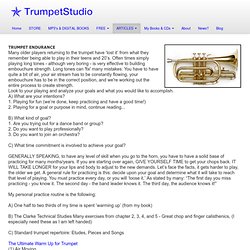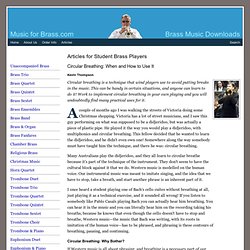

Trumpet Lessons Endurance Getting Tired Playing the Trumpet Longer Trumpet Endurance How to Play the Trumpet Longer Using Long Tones To Increase Endurance. TRUMPET ENDURANCEMany older players returning to the trumpet have ‘lost it’ from what they remember being able to play in their teens and 20’s.

Often times simply playing long tones - although very boring - is very effective to building embouchure strength. Long tones can 'fix' many mistakes: You have to have quite a bit of air, your air stream has to be constantly flowing, your embouchure has to be in the correct position, and we're working out the entire process to create strength.Look to your playing and analyze your goals and what you would like to accomplish.A) What are your intentions? 1. Playing for fun (we’re done, keep practicing and have a good time!) 2. B) What kind of goal? C) What time commitment is involved to achieve your goal? GENERALLY SPEAKING, to have any level of skill when you go to the horn, you have to have a solid base of practicing for many months/years.
My personal practice routine is the following: C) Standard trumpet repertoire: Etudes, Pieces and Songs. INSTRUMENT MAINTENANCE 101: PLEASE WATCH THIS VIDEO! My Daily Trumpet Warmup Routine. Bill Carmichael - A Quick Trumpet Warm-Up Exercise. How to Circular Breathe on the Trumpet. Circular breathing. Davul and zurna players.

Wind players use circular breathing. Circular breathing is a technique used by players of some wind instruments to produce a continuous tone without interruption. This is accomplished by breathing in through the nose while simultaneously pushing air out through the mouth using air stored in the cheeks. History[edit] In the 13th century, Asian metalsmiths who specialized in gold and silver used circular breathing techniques for crafting various decorative and ornamental items. Uses[edit] It is used extensively in playing the Eastern zurna, the Mongolian limbe, the Sardinian launeddas, the Egyptian arghul, the Australian didgeridoo, as well as many traditional oboes and flutes of Asia and the Middle East. Although many professional wind players find circular breathing highly useful, few pieces of European orchestral music composed before the 20th century actually require its use.
In 1997, a Guinness World Record was set for longest held musical note. Method[edit] Circular Breathing: When and How to Use It - Music for Brass.com. Circular Breathing: When and How to Use It Kevin Thompson Circular breathing is a technique that wind players use to avoid putting breaks in the music.

This can be handy in certain situations, and anyone can learn to do it! Work to implement circular breathing in your own playing and you will undoubtedly find many practical uses for it. A couple of months ago I was walking the streets of Victoria doing some Christmas shopping. Many Australians play the didjeridoo, and they all learn to circular breathe because it's part of the technique of the instrument. I once heard a student playing one of Bach's cello cuites without breathing at all, just playing it as a technical exercise, and it sounded all wrong!
Circular Breathing: Why Bother? If Western music is all about phrasing, and breathing is a necessary part of our music, then why bother learning to circular breathe? Well, there are some Western composers who don't seem to have realized that brass players need to breathe. Repeat forever!
Master Superchops Jerome Callet Disc 2. Trumpet Lesson: Six Notes To Better Embouchure. How to expand your trumpet range: 3 steps! Vizzutti Range Exercise. Master Superchops Jerome Callet Disc 1. How to Play High Notes On the Trumpet!